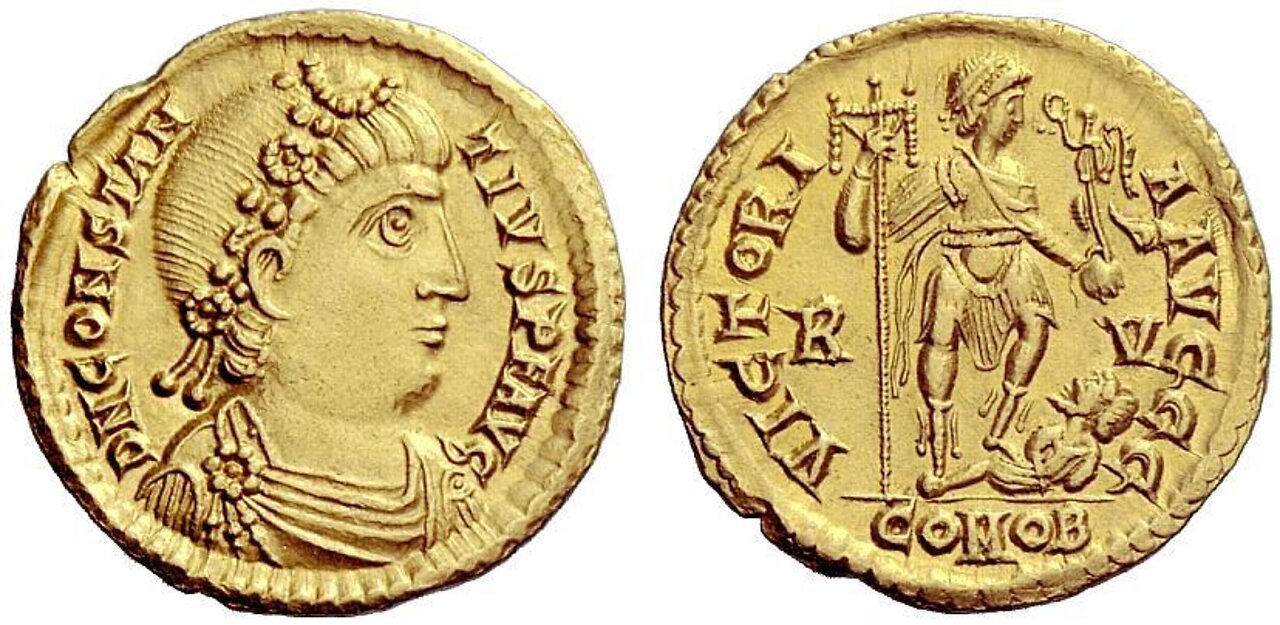Premium Only Content

NVMMVS: D N CONSTAN – TIVS P F AVG VICTORI – A AVGGG R+V COMOB (421 A.D.)
NVMMVS: D N CONSTAN – TIVS P F AVG VICTORI – A AVGGG R+V COMOB (421 A.D.)
http://zazzle.com/ProVaticanus
The Roman Empire, Constantius III, 8th February – 2nd September 421, Solidus, Ravenna 421, AV 4.46 g. D N CONSTAN – TIVS P F AVG Rosette-diademed, draped and cuirassed bust r. Rev. VICTORI – A AVGGG Emperor standing facing, head r., holding standard and Victory on globe, spurning captive with his l. foot; in field, R – V. In exergue, COMOB. C 1. RIC 1325. Depeyrot 7/4. Ranieri 48. Extremely rare and among the finest specimens known. Well struck and centred on a full flan and extremely fine Ex NFA XXX, 1992, 315 and NAC 38, 2007, 290 sales. The Danubian commander Constantius III had enjoyed a stellar career by the time he undertook a naval blockade of Spain and Gaul in 415, which caused the murder of the Visigothic king Athaulf. In achieving this victory Constantius secured the return of the emperor Honorius’ half-sister Galla Placidia, who had been captured by the Visigoths when they sacked Rome in 410, and who in the meantime had been forced to marry king Athaulf. Riding the tide of his triumph, Constantius pressed for a royal marriage with the rescued empress, which occurred on January 1, 417, when he also assumed his second consulship. Slightly more than four years passed before Constantius gained enough prestige at court that Honorius reluctantly declared him co-emperor. This elevation was well-received in the West, where the soldiers were relieved to have a proven soldier sharing the throne, but it was not acknowledged by the Eastern emperor Theodosius II. The specter of civil war loomed for seven months until the stalemate was finally resolved by Constantius’ death, seemingly of natural causes, on September 2, 421. Due in part to the brevity of his reign, only gold solidi and tremisses from Ravenna were struck in Constantius’ name. Beyond coinage, his other lasting legacy was his son Valentinian III, by Galla Placidia, who eventually ruled the Western Roman Empire, albeit impotently, for thirty years.
Flavius Constantius was a former officer of the magister militum Stilicho († 408), whose star rose as a consequence of the disastrous situation of the Western Empire after the Crossing of the Rhine on 31 December 406 (or 405), the usurpation of Constantine III in 407 and the Sack of Rome by Alarich on 24 August 410. In these desperate times, it was Constantius' military brilliance that initiated a wondrous revival of Roman might: as magister utriusque militiae ('master of both forces', i.e. commander of both the infantry and cavalry), he first defeated Constantine III in 411 (see above, lot 1843) and then expelled Alaric from Italy in 412. A year later, he overcame and killed his Roman rival, the comes africae Heraclianus, before successfully campaigning against the Visigoths in Spain and Gaul in 415-416, thus ensuring the release of Honorius' half-sister Galla Placidia from Gothic captivity. Once the brilliant general gradually gained back control over large parts of the Western Empire, his stellar ascent knew no limits: in 417, Constantius married Galla Placidia and became the brother-in-law of Honorius, who was merely a puppet in his hands and proclaimed him to his co-emperor on 8 February 421. Within a decade, Constantius had raised the Western Empire from the dead, married into the Theodosian dynasty and become the true power holder in Ravenna. However, on 2 September 421, the great general suddenly died of an illness, allegedly amidst preparations for war against Theodosius II, as the eastern emperor had declined recognition of Constantius' elevation to the rank of Augustus. The unexpected demise of Constantius has been termed by some modern historians the beginning of the end of the Western Roman Empire, as none of its later magistri militum would turn out to be nearly as successful. However, the dark prospect of another disastrous civil war looming on the horizon casts doubt on whether Constantius III would really have been able to stem the tide for the Western Roman Empire, as clashes with the Theodosian dynasty seemed unavoidable.
Gratias ago tibi Deo per instrumenta de Jove Mauro Cámara pro bono rei publicae.
#RomanEmpire #ConstantiusIII #Numismatics
http://patreon.com/ProVaticanus
-
 0:55
0:55
ProVaticanus
1 month ago#shorts : Ο Χριστόφορος Κολόμβος τῷ θεῷ διά την λῐ́μνην ☧ Deo per rivum Christophorus Columbus ✠
301 -
 1:19:32
1:19:32
The Daily Signal
6 hours ago $2.58 earned🚨BREAKING: James Comey & Letitia James NOT "Off the Hook" on Indictments, Sen. Kelly Court Martial?
9.51K1 -
 LIVE
LIVE
Drew Hernandez
21 hours agoBONDI DOJ BLOWS IT ON COMEY/LETICIA INDICTMENTS?!
929 watching -
 LIVE
LIVE
PandaSub2000
4 days agoLIVE 10:30pm ET | CARMEN SANDIEGO
255 watching -
 12:10
12:10
Robbi On The Record
1 day ago $2.37 earnedKarmic Disclosure and Predictive Programming
16.6K3 -
 4:57
4:57
Gamazda
4 hours ago $2.10 earnedAerosmith - Dream On (Piano by Gamazda)
11.3K8 -
 8:12
8:12
Freedom Frontline
7 hours agoChip Roy DESTROYS Democrat After She Explodes Over Shutdown Truth
7.62K -
 LIVE
LIVE
We Like Shooting
15 hours ago $1.15 earnedWe Like Shooting 638 (Gun Podcast)
231 watching -
 46:09
46:09
MattMorseTV
4 hours ago $19.65 earned🔴Bondi just DROPPED the BALL... BIG TIME.🔴
20.9K118 -
 23:57
23:57
Jasmin Laine
8 hours agoCarney SNAPS at Reporters—MOCKS Trump and it BACKFIRES IMMEDIATELY
14K30